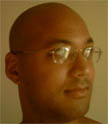Cloak of invisibility: Fact or fiction?
Scientists boldly go where only science fiction has been before
The Associated Press
Updated: 11:46 a.m. ET Oct 19, 2006
WASHINGTON - Harry Potter and Captain Kirk would be proud. A team of American and British researchers has made a Cloak of Invisibility.
Well, OK, it’s not perfect. Yet.
But it’s a start, and it did a pretty good job of hiding a copper cylinder. In this experiment the scientists used microwaves to try and detect the cylinder. Like light and radar waves, microwaves bounce off objects making them visible and creating a shadow, though it has to be detected with instruments.
If you can hide something from microwaves, you can hide it from radar — a possibility that will fascinate the military. Cloaking differs from stealth technology, which doesn’t make an aircraft invisible but reduces the cross-section available to radar, making it hard to track. Cloaking simply passes the radar or other waves around the object as if it weren’t there, like water flowing around a smooth rock in a stream.
The new work points the way for an improved version that could hide people and objects from visible light. Conceptually, the chance of adapting the concept to visible light is good, cloak designer David Schurig said in a telephone interview. But Schurig, a research associate in Duke University’s electrical and computer engineering department, added, “From an engineering point of view it is very challenging.”
Nonetheless, the cloaking of a cylinder from microwaves comes just five months after Schurig and colleagues published their theory that it should be possible. Their first success is reported in a paper in Friday’s issue of the journal Science.
"We did this work very quickly ... and that led to a cloak that is not optimal,” said co-author David R. Smith, also of Duke. “We know how to make a much better one.”
Casting a shadow
The first working cloak was in only two dimensions and did cast a small shadow, Smith acknowledged. The next step is to go for three dimensions and to eliminate any shadow. Viewers can see things because objects scatter the light that strikes them, reflecting some of it back to the eye.
“The cloak reduces both an object’s reflection and its shadow, either of which would enable its detection,” said Smith.
In effect the device, made of meta-materials — engineered mixtures of metal and circuit board materials, which could include ceramic, Teflon or fiber composite materials — channels the microwaves around the object being hidden.
When water flows around a rock, Smith explained, the water recombines after it passes the rock and people looking at the water downstream would never know it had passed a rock. The cloaking has to be designed for specific bandwidths of radiation. In this case it’s microwaves, and someone measuring them wouldn’t be able to tell they had passed around an object. The hope is to do the same for light waves. Looking at a cloaked item, Smith explained: “One would see whatever is behind the cloak. That is, the cloak is, ideally, transparent. Since we do not have a perfect cloak at this point, there is some reflection and some shadow, meaning that the background would still be visible just darkened somewhat.
The ideal cloak would have nearly negligible reflection and virtually no shadowing, Smith said.
“This first experiment has provided a confirmation that the mechanism of cloaking can be realized, we now just need to improve the performance of cloaking structures.”
Other possibilities
In addition to hiding things, redirecting electromagnetic waves could prove useful in protecting sensitive electronics from harmful radiation, Smith commented. In a very speculative application, he added, “one could imagine ’cloaking’ acoustic waves, so as to shield a region from vibration or seismic activity.”
Natalia M. Litchinitser, a researcher at the University of Michigan department of electrical engineering and computer science, said this appears to be the “first, to the best of my knowledge, experimental realization of the fascinating idea of cloaking based on meta-materials at microwave frequencies.”
“Although the invisibility reported in this paper is not perfect, this work provides a proof-of-principle demonstration of the possibility,” said Litchinitser, who was not part of the research team. She added that the next breakthrough is likely to be an experimental demonstration of the cloaking in visible light. “These ideas represent a first step toward the development of functional materials for a wide spectrum of civil and military applications.”
Joining Schurig and Smith in the work were researchers at Imperial College in London and SensorMetrix, a materials and technology company in San Diego, Calif. The research was supported by the Intelligence Community Postdoctoral Research Fellowship Program and the United Kingdom Engineering and Physical Sciences Research Council.
© 2006 The Associated Press. All rights reserved.
URL: http://www.msnbc.msn.com/id/15329396/


